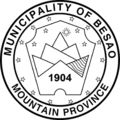Besao | |
|---|---|
| Municipality of Besao | |
 | |
 Map of Mountain Province with Besao highlighted | |
 Interactive map of Besao | |
Location within the Philippines | |
| Coordinates: 17°05′43″N120°51′22″E / 17.0953°N 120.8561°E | |
| Country | Philippines |
| Region | Cordillera Administrative Region |
| Province | Mountain Province |
| District | Lone district |
| Founded | 1904 |
| Barangays | 14 (see Barangays) |
| Government | |
| • Type | Sangguniang Bayan |
| • Mayor | Bryne O. Bacwaden |
| • Vice Mayor | Elizabeth A. Buyagan |
| • Representative | Maximo Y. Dalog Jr. |
| • Municipal Council | Members |
| • Electorate | 6,277 voters (2025) |
| Area | |
• Total | 173.62 km2 (67.04 sq mi) |
| Elevation | 1,405 m (4,610 ft) |
| Highest elevation | 2,059 m (6,755 ft) |
| Lowest elevation | 721 m (2,365 ft) |
| Population (2024 census) [3] | |
• Total | 6,315 |
| • Density | 36.37/km2 (94.20/sq mi) |
| • Households | 1,738 |
| Economy | |
| • Income class | 5th municipal income class |
| • Poverty incidence | 6.82 |
| • Revenue | ₱ 121.8 million (2022) |
| • Assets | ₱ 301.1 million (2022) |
| • Expenditure | ₱ 86.81 million (2022) |
| • Liabilities | ₱ 44.39 million (2022) |
| Service provider | |
| • Electricity | Mountain Province Electric Cooperative (MOPRECO) |
| Time zone | UTC+8 (PST) |
| ZIP code | 2618 |
| PSGC | |
| IDD : area code | +63 (0)74 |
| Native languages | Balangao Bontoc Ilocano Tagalog Applai Kankanaey |
| Website | besao |
Besao, officially the Municipality of Besao is a municipality in the province of Mountain Province, Philippines. According to the 2024 census, it has a population of 6,315 people. [5]
Contents
- Geography
- Barangays
- Climate
- Demographics
- Religion
- Economy
- Government
- Local government
- Elected officials
- Education
- Primary and elementary schools
- Secondary schools
- References
- External links
The town is known for the Agawa people's Agricultural Stone Calendar of Gueday. The stone calendar is one of the most enigmatic artifact in the Cordillera mountains. It is a testimony to the accurate scientific outlook of the ancient Agawa people in the cycle of weathers, agriculture, and heavenly bodies. [6]



